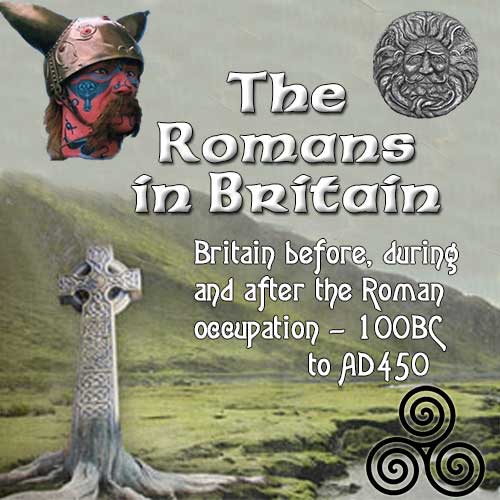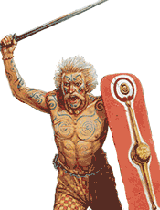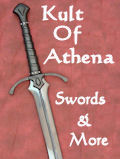Celtic Society
Celtic society
Warriors and craftsmen (this included druids and bards) were held in high regard in Celtic society and were considered to be part of the noble class. A king or chief was in charge. Farmers were part of the lower class in Celtic society. Despite their reputation as being barbaric, they were quite skilled in metal working and made fine jewelry from gold, silver, copper and bronze. Celts took great care in their appearance and frowned on those who let their bodies get soft. Brightly colored cloaks, golden torcs and bronze armlets adorned their bodies to express their wealth and high rank. Celtic women wore makeup and styled their hair in plaits.
Celtic Women
‘The women of the Gauls are not only like men in their great stature, but they are a match for them in courage as well.’
Celtic women had fierce pride and they enjoyed a freedom and power that women in ancient Rome did not have. I think what I like about the Celts is they had a more balanced society. Though they were a warrior society, their gods and goddesses were equal and that was not the case in other religions. There is not a lot of evidence pointing to women warriors among the Celts, but Queen Boudica led an army against the Romans around AD60. Celtic women were not to be messed with.
Though public life among the Iron Age Celts was largely the domain of men, women managed to play a prominent role as well. They seem not to have been systematically excluded from any occupation. Women could become druids, including priestesses, poets, and healers. They could conduct business without the consent or involvement of their husbands.
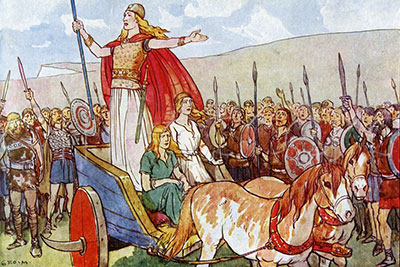 The Romans did not take female rulers seriously and sought to take advantage of what they considered to be the weakness of the Iceni at this time. Catus Decianus, the Roman in charge of collecting Rome’s share of the inheritance, insulted the Iceni through a series of horrific acts. He ordered his troops to loot their property, flog Boudicca in public, and rape her daughters repeatedly. Boudicca responded by leading a revolt of her people’s forces and those of several other tribes that had grown resentful of the invading Romans. The rebels leveled the Roman administrative center of Londinium (modern-day London) and sacked two other Roman towns before being defeated. Boudicca’s ability to unite her people in revolt was remarkable considering the destabilizing Celtic penchant for individual glory, a consistent precipitating factor in the fall of Celtic Europe to Roman expansion.
The Romans did not take female rulers seriously and sought to take advantage of what they considered to be the weakness of the Iceni at this time. Catus Decianus, the Roman in charge of collecting Rome’s share of the inheritance, insulted the Iceni through a series of horrific acts. He ordered his troops to loot their property, flog Boudicca in public, and rape her daughters repeatedly. Boudicca responded by leading a revolt of her people’s forces and those of several other tribes that had grown resentful of the invading Romans. The rebels leveled the Roman administrative center of Londinium (modern-day London) and sacked two other Roman towns before being defeated. Boudicca’s ability to unite her people in revolt was remarkable considering the destabilizing Celtic penchant for individual glory, a consistent precipitating factor in the fall of Celtic Europe to Roman expansion.
Celtic Warriors
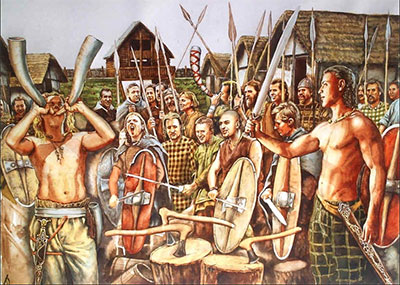 Celtic warriors have been described as resembling the Roman god, Pan, for the way they lime their hair and make it stand up and pull it back to the nape of their neck. This was probably a battle tactic to make themselves look frightening to the enemy. They also beat their swords and spears against their leather shields, creating an awful sound meant to scare the enemy. In earlier times, they even fought naked. Fierce and proud, warriors liked to boast about their feats of great valor on the battlefield.
Celtic warriors have been described as resembling the Roman god, Pan, for the way they lime their hair and make it stand up and pull it back to the nape of their neck. This was probably a battle tactic to make themselves look frightening to the enemy. They also beat their swords and spears against their leather shields, creating an awful sound meant to scare the enemy. In earlier times, they even fought naked. Fierce and proud, warriors liked to boast about their feats of great valor on the battlefield.
Celtic Men
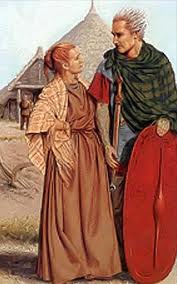 Celtic men wore their hair long and shaggy and the nobles had long mustaches. They painted themselves with blue paint called woad. The Picts in the Scottish highlands were heavily tattooed, even their women. There is some debate as to whether the Picts were Celtic, but I am sure they inter-married. I like to compare them to modern day rockers or metal heads. They wore colorful dyed tunics and trousers or bracae. Their cloaks were striped and held together with a brooch. They took great care in their appearance to impress each other and to alarm their enemies. The men wore just as much jewelry as the women to show off their wealth.
Celtic men wore their hair long and shaggy and the nobles had long mustaches. They painted themselves with blue paint called woad. The Picts in the Scottish highlands were heavily tattooed, even their women. There is some debate as to whether the Picts were Celtic, but I am sure they inter-married. I like to compare them to modern day rockers or metal heads. They wore colorful dyed tunics and trousers or bracae. Their cloaks were striped and held together with a brooch. They took great care in their appearance to impress each other and to alarm their enemies. The men wore just as much jewelry as the women to show off their wealth.

